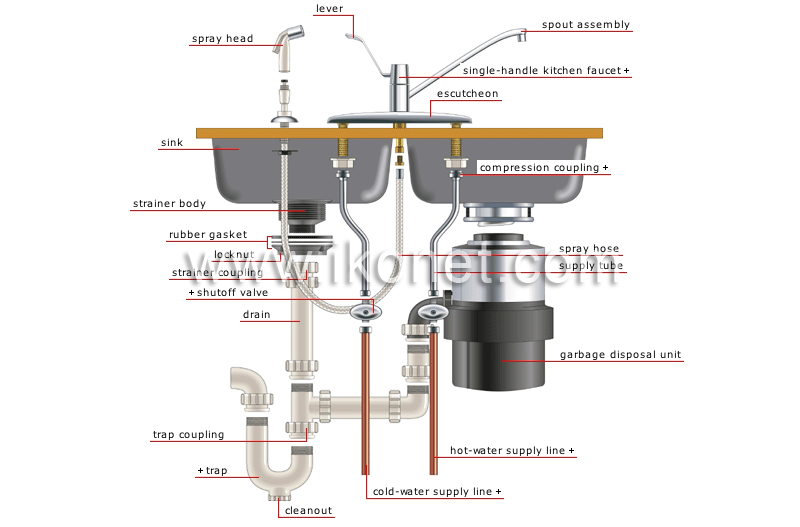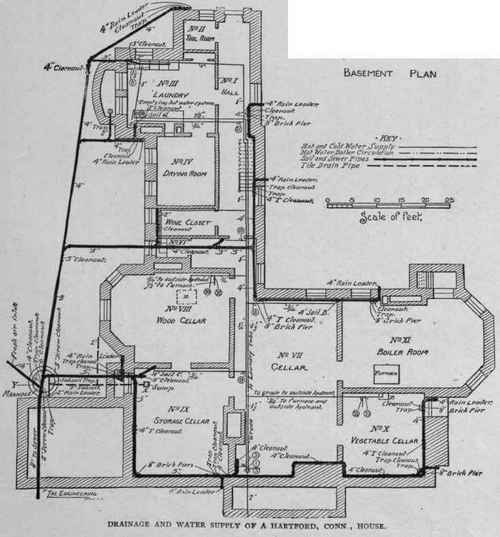On this page underneath yow will discover a good deal of really good content in relation to Exploring Your Homes Plumbing Anatomy.

Recognizing how your home's pipes system works is necessary for every single house owner. From delivering tidy water for drinking, cooking, and showering to safely removing wastewater, a well-kept plumbing system is crucial for your family's wellness and comfort. In this detailed overview, we'll explore the elaborate network that composes your home's plumbing and offer ideas on maintenance, upgrades, and taking care of common concerns.
Introduction
Your home's plumbing system is greater than simply a network of pipes; it's a complicated system that guarantees you have accessibility to clean water and effective wastewater elimination. Recognizing its components and exactly how they interact can help you stop expensive repair services and make sure whatever runs efficiently.
Basic Components of a Plumbing System
Pipes and Tubes
At the heart of your pipes system are the pipelines and tubes that carry water throughout your home. These can be made from numerous materials such as copper, PVC, or PEX, each with its advantages in regards to longevity and cost-effectiveness.
Fixtures: Sinks, Toilets, Showers, etc.
Components like sinks, bathrooms, showers, and bath tubs are where water is made use of in your home. Recognizing exactly how these components attach to the pipes system helps in diagnosing issues and preparing upgrades.
Shutoffs and Shut-off Factors
Valves control the circulation of water in your plumbing system. Shut-off valves are important throughout emergencies or when you need to make repair work, allowing you to separate parts of the system without interfering with water flow to the entire home.
Water System System
Key Water Line
The major water line links your home to the local water system or an exclusive well. It's where water enters your home and is dispersed to various components.
Water Meter and Stress Regulatory Authority
The water meter procedures your water usage, while a pressure regulator guarantees that water flows at a safe stress throughout your home's pipes system, stopping damages to pipes and fixtures.
Cold Water vs. Hot Water Lines
Understanding the distinction between cold water lines, which provide water straight from the major, and hot water lines, which carry heated water from the hot water heater, aids in repairing and preparing for upgrades.
Water drainage System
Drain Pipes Water Lines and Traps
Drain pipes bring wastewater far from sinks, showers, and commodes to the sewage system or septic tank. Traps prevent sewer gases from entering your home and also trap debris that could create obstructions.
Ventilation Pipelines
Air flow pipelines enable air right into the water drainage system, protecting against suction that can reduce water drainage and create catches to vacant. Correct air flow is vital for preserving the integrity of your plumbing system.
Significance of Correct Drain
Ensuring correct drain protects against backups and water damages. Consistently cleaning up drains and maintaining traps can prevent pricey repairs and prolong the life of your plumbing system.
Water Furnace
Types of Hot Water Heater
Water heaters can be tankless or traditional tank-style. Tankless heating units warmth water as needed, while tanks keep warmed water for immediate usage.
How Water Heaters Connect to the Plumbing System
Recognizing how hot water heater link to both the cold water supply and warm water circulation lines helps in detecting problems like insufficient hot water or leakages.
Maintenance Tips for Water Heaters
Regularly flushing your hot water heater to eliminate debris, checking the temperature level settings, and examining for leakages can prolong its lifespan and enhance power performance.
Usual Pipes Concerns
Leaks and Their Reasons
Leaks can happen due to aging pipes, loose fittings, or high water pressure. Resolving leakages without delay prevents water damages and mold and mildew development.
Blockages and Obstructions
Blockages in drains and toilets are often brought on by purging non-flushable things or a build-up of oil and hair. Making use of drain screens and being mindful of what goes down your drains pipes can protect against blockages.
Signs of Pipes Problems to Watch For
Low tide pressure, slow drains pipes, foul odors, or abnormally high water costs are indications of potential pipes issues that need to be addressed immediately.
Plumbing Upkeep Tips
Routine Evaluations and Checks
Set up annual pipes assessments to capture problems early. Seek indicators of leaks, deterioration, or mineral buildup in faucets and showerheads.
DIY Upkeep Tasks
Simple jobs like cleaning tap aerators, checking for commode leaks utilizing dye tablets, or insulating subjected pipes in cool environments can avoid significant plumbing issues.
When to Call a Professional Plumbing Professional
Know when a plumbing issue calls for expert competence. Trying complex repair work without correct knowledge can lead to even more damage and greater repair work prices.
Upgrading Your Plumbing System
Factors for Updating
Upgrading to water-efficient fixtures or changing old pipelines can improve water high quality, reduce water bills, and boost the worth of your home.
Modern Pipes Technologies and Their Benefits
Check out technologies like smart leak detectors, water-saving bathrooms, and energy-efficient hot water heater that can save money and minimize ecological impact.
Cost Factors To Consider and ROI
Compute the ahead of time prices versus long-term cost savings when taking into consideration plumbing upgrades. Many upgrades pay for themselves with lowered utility costs and fewer repairs.
Ecological Influence and Preservation
Water-Saving Components and Appliances
Installing low-flow taps, showerheads, and toilets can considerably minimize water use without compromising efficiency.
Tips for Lowering Water Usage
Easy practices like repairing leaks quickly, taking shorter showers, and running full loads of laundry and recipes can preserve water and reduced your utility bills.
Eco-Friendly Plumbing Options
Consider sustainable plumbing products like bamboo for floor covering, which is durable and eco-friendly, or recycled glass for countertops.
Emergency situation Readiness
Steps to Take During a Plumbing Emergency situation
Know where your shut-off valves lie and just how to shut off the water in case of a ruptured pipeline or major leak.
Value of Having Emergency Situation Contacts Convenient
Maintain contact details for neighborhood plumbings or emergency services easily offered for fast feedback throughout a plumbing crisis.
DIY Emergency Fixes (When Suitable).
Temporary solutions like using duct tape to spot a dripping pipeline or putting a bucket under a dripping faucet can decrease damage until a specialist plumbing gets here.
Final thought.
Comprehending the composition of your home's pipes system encourages you to preserve it efficiently, conserving money and time on repair work. By following regular upkeep routines and staying notified regarding modern pipes modern technologies, you can ensure your plumbing system runs effectively for years ahead.
HOW YOUR PLUMBING SYSTEM WORKS
Which Pipes Do What?
Blue lines = fresh water supply entering the building
Red lines = hot water supply entering the building
Grey lines = pipes carrying waste away from the building and venting pipes carrying gases away from the building (through the roof)
YOUR MAIN PLUMBING SYSTEMS
There are two main plumbing systems that support your home s basic plumbing needs one that brings clean water into your home, and one that sends dirty water away from your home. Connected to the toilet, bath, shower, and other faucets in your home, these two systems keep your water flowing in the right directions.
ACCESSING FRESH WATER
Fresh and clean water is brought into your home through the main water supply line . Filtered through one pipe, this water is pressured to flow into the various fixtures in your home at any given time.
This water can be sourced from a well located on your property, a pond or river (mostly cottages), or, as in most cases, from the city s municipal water treatment centre. However, it is important to note that water that is untreated, such as the water siphoned from ponds or rivers, may not be safe to drink. Personal water supplies always need to be treated for hardness and contaminants before consumed.
MUNICIPAL WATER SUPPLIES
Improve taste and odour
Remove sediment
Eliminate hardness
Reduce chlorine
COLD WATER SUPPLY VS. HOT WATER SUPPLY
Cold water flows into your home or building through the service line, which then distributes hot or cold water to your fixtures. This line is most commonly run through a central column that runs floor to floor. Hot water runs in short and straight pipes as the longer the pipeline, the more heat that will be lost in the transfer. Having shorter pipes also allows residents to access hot water more quickly.
WASTE WATER SYSTEM
Your wastewater system is divided into two parts pipes that send wastewater away from your home and venting pipes that send sewer gas away from your home. Sewage water travels through pipes that flush the water and waste towards local sewers that are operated and managed by your city or town. Most sewer systems rely on gravity to move the wastewater to where it needs to go.
The further away from your toilet or sink, the larger wastewater pipes become. This allows for waste to be disposed of from various parts of your home or business at once without pipe blockages. The angle and flow of these pipes are also essential for keeping your waste pipes clear of build up.
https://harrisplumbing.ca/how-your-home-plumbing-system-works/

HOW YOUR PLUMBING SYSTEM WORKS
Which Pipes Do What?
YOUR MAIN PLUMBING SYSTEMS
There are two main plumbing systems that support your home s basic plumbing needs one that brings clean water into your home, and one that sends dirty water away from your home. Connected to the toilet, bath, shower, and other faucets in your home, these two systems keep your water flowing in the right directions.
ACCESSING FRESH WATER
Fresh and clean water is brought into your home through the main water supply line . Filtered through one pipe, this water is pressured to flow into the various fixtures in your home at any given time.
This water can be sourced from a well located on your property, a pond or river (mostly cottages), or, as in most cases, from the city s municipal water treatment centre. However, it is important to note that water that is untreated, such as the water siphoned from ponds or rivers, may not be safe to drink. Personal water supplies always need to be treated for hardness and contaminants before consumed.
MUNICIPAL WATER SUPPLIES
COLD WATER SUPPLY VS. HOT WATER SUPPLY
Cold water flows into your home or building through the service line, which then distributes hot or cold water to your fixtures. This line is most commonly run through a central column that runs floor to floor. Hot water runs in short and straight pipes as the longer the pipeline, the more heat that will be lost in the transfer. Having shorter pipes also allows residents to access hot water more quickly.
WASTE WATER SYSTEM
Your wastewater system is divided into two parts pipes that send wastewater away from your home and venting pipes that send sewer gas away from your home. Sewage water travels through pipes that flush the water and waste towards local sewers that are operated and managed by your city or town. Most sewer systems rely on gravity to move the wastewater to where it needs to go.
The further away from your toilet or sink, the larger wastewater pipes become. This allows for waste to be disposed of from various parts of your home or business at once without pipe blockages. The angle and flow of these pipes are also essential for keeping your waste pipes clear of build up.
https://harrisplumbing.ca/how-your-home-plumbing-system-works/
As an enthusiastic reader about Exploring Your Homes Plumbing Anatomy, I thought sharing that article was worth the trouble. Appreciated our entry? Please share it. Let somebody else locate it. Thank you for being here. Please visit our blog back soon.
Learn More